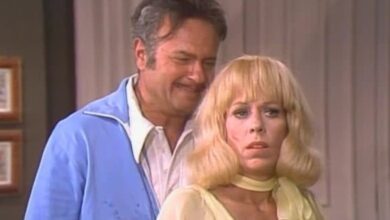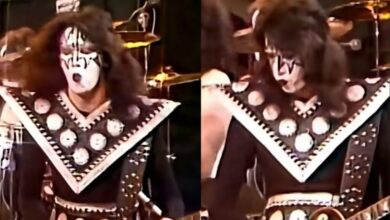Brian Hyland’s ‘Itsy Bitsy Teenie Weenie Yellow Polka Dot Bikini’ Adds a Playful Splash to the Pop Charts in 1960
In the warm summer months of 1960, Itsy Bitsy Teenie Weenie Yellow Polka Dot Bikini exploded onto the music scene, introducing a fresh face to pop: Brian Hyland. This playful, catchy tune instantly captured the public’s imagination, reflecting the lighthearted and adventurous spirit of a new youth-driven era. Its infectious melody and whimsical storytelling made it an irresistible hit, soaring to No. 1 on the Billboard Hot 100 and planting the seeds for the emerging bubblegum pop trend.
At just 16 years old, Brian Hyland found himself catapulted into the national spotlight. Born in Queens, New York, in 1943, Hyland nurtured his passion for music early, singing in various doo-wop groups before catching the attention of record labels. His boyish charm and polished voice made him an instant fit for the growing roster of teen idols captivating America at the time. Although he later matured into more serious material, this initial success etched his name into pop music history.
The creative minds behind Itsy Bitsy Teenie Weenie Yellow Polka Dot Bikini were Paul Vance and Lee Pockriss, a songwriting duo adept at crafting cheerful, accessible hits. Inspired by a real incident involving Vance’s daughter feeling embarrassed in her new swimsuit, the pair turned a relatable moment of youthful shyness into a cheeky, light-hearted song. Underneath its fun exterior, the song hinted at shifting social attitudes regarding fashion and modesty, cleverly anchoring itself in the cultural changes of the time.
Recording the song at Bell Sound Studios in New York City, producer Lee Pockriss shaped a vibrant, upbeat arrangement filled with bouncing rhythms, a spirited brass section, and lively percussion. Hyland’s youthful delivery perfectly matched the whimsical lyrics, bringing them to life with wide-eyed enthusiasm. Backup singers punctuated key moments with playful chants, adding further energy and charm. Every element came together to create a track that felt like pure, bottled summer joy.
When it hit the airwaves, the reaction was immediate and electric. Released in July 1960, Itsy Bitsy Teenie Weenie Yellow Polka Dot Bikini quickly climbed the Billboard charts, claiming the No. 1 spot within weeks. It became a fixture at beach parties, pool gatherings, and on jukeboxes across the country. The song’s appeal extended beyond American shores, reaching audiences in the United Kingdom, where it broke into the Top 10, and helping cement its place as a global summertime anthem.
At a time when the bikini was still considered scandalous by many, the song’s playful humor helped ease its way into mainstream fashion acceptance. Bikinis had been around since the late 1940s, but widespread societal acceptance lagged behind. Through its comic storytelling, Itsy Bitsy Teenie Weenie Yellow Polka Dot Bikini helped demystify and even celebrate the once-controversial swimwear, serving as a cultural bridge between the conservative ‘50s and the more liberated ‘60s.
For Brian Hyland, the sudden fame brought both opportunity and obstacles. While Itsy Bitsy Teenie Weenie Yellow Polka Dot Bikini solidified his entry into pop stardom, it also labeled him in the public eye as a novelty singer. Determined to prove his versatility, Hyland shifted toward more serious ballads in the years that followed, achieving renewed success with heartfelt hits like Sealed with a Kiss in 1962 and Gypsy Woman in 1970. Nevertheless, this playful summer song remained forever tied to his name.
The wider impact of the song stretched far beyond Hyland’s own discography. Itsy Bitsy Teenie Weenie Yellow Polka Dot Bikini helped shape the emerging bubblegum pop genre, paving the way for acts like The Archies and The Monkees. These later groups adopted the formula of infectious melodies, simple lyrics, and youthful exuberance that Hyland’s breakout hit had perfected. The song became a lasting emblem of carefree pop and was repeatedly featured on countless summer-themed music compilations.
Over time, new generations discovered and reimagined the song. In 1990, British pop group Bombalurina, led by TV presenter Timmy Mallett, revived Itsy Bitsy Teenie Weenie Yellow Polka Dot Bikini for a new audience, taking it to No. 1 on the UK charts. Throughout the decades, artists across various genres have offered their takes on the classic, from dancefloor remixes to international covers, proving that its appeal transcends musical and cultural boundaries.
During its original release, Itsy Bitsy Teenie Weenie Yellow Polka Dot Bikini represented more than just a cute story. It captured a pivotal moment when the cultural tides were shifting toward youth empowerment, body positivity, and playful self-expression. While heavier political and social movements were still on the horizon, this song offered a lighthearted glimpse of the changing times through the lens of pop music’s joyful simplicity.
Even decades after its first appearance, the song remains a staple of retro pop culture. Whether in beach-themed movie scenes, nostalgic TV commercials, or themed parties, its bright and breezy vibe continues to bring smiles. It evokes memories of sun-drenched afternoons, playful innocence, and a period when pop music could transform a simple story into a lasting phenomenon.
In the grand scheme of music history, Itsy Bitsy Teenie Weenie Yellow Polka Dot Bikini stands as more than just a novelty. It captures the optimism, fun, and rapid social changes of the early 1960s with disarming simplicity. While Brian Hyland evolved musically over the years, this timeless song remains his signature piece, reminding listeners of the enduring charm of youthful, playful pop.





